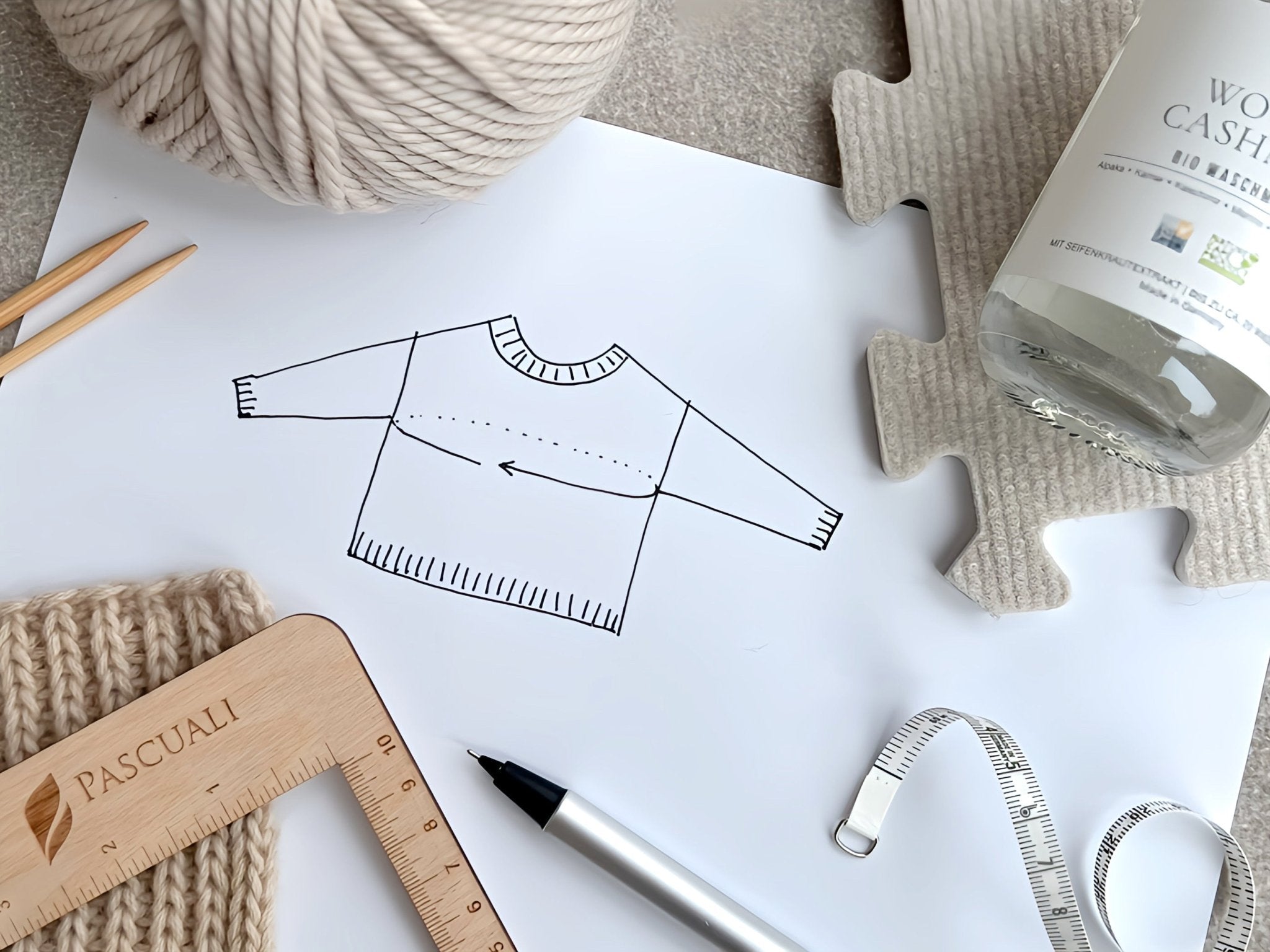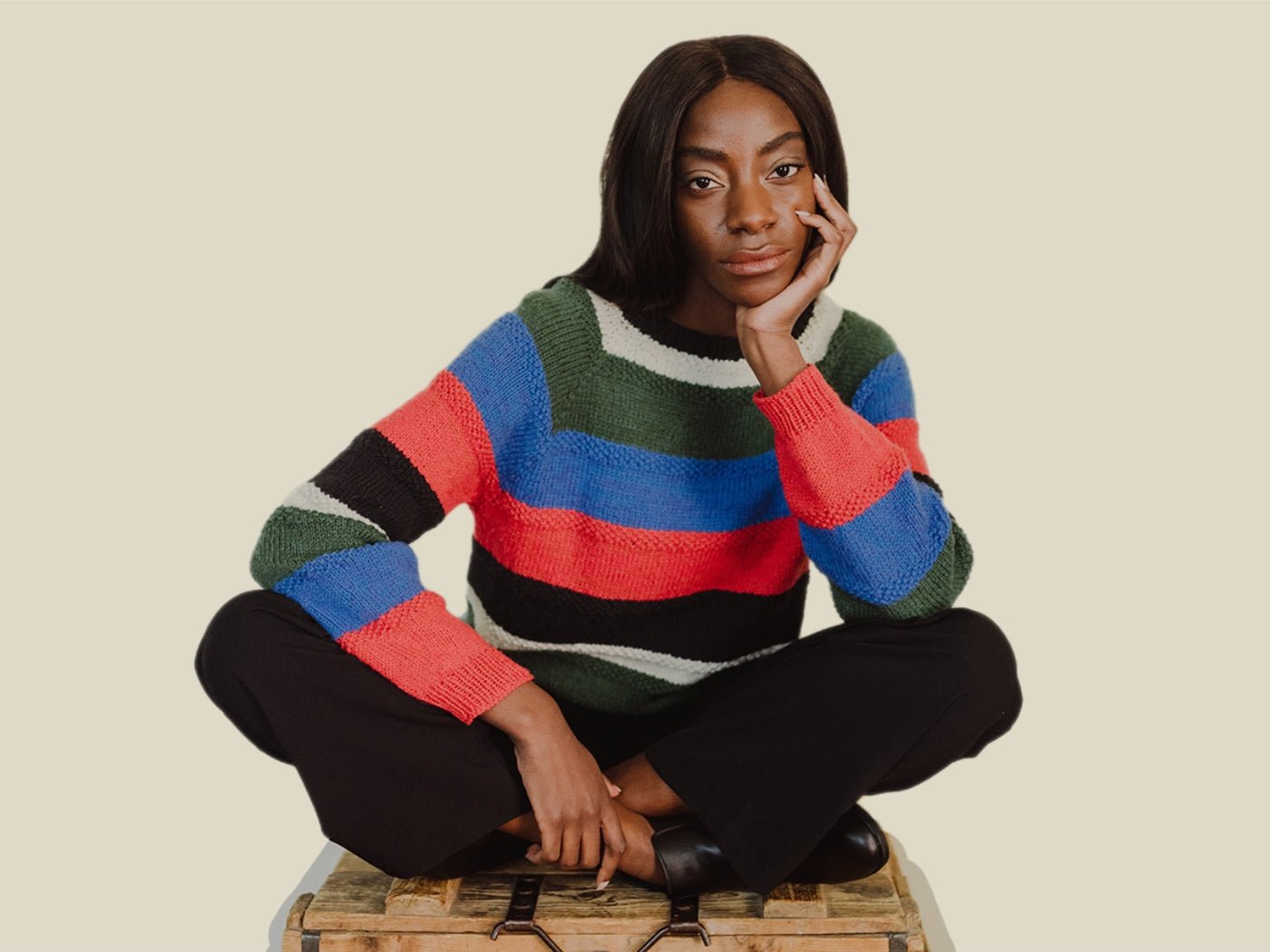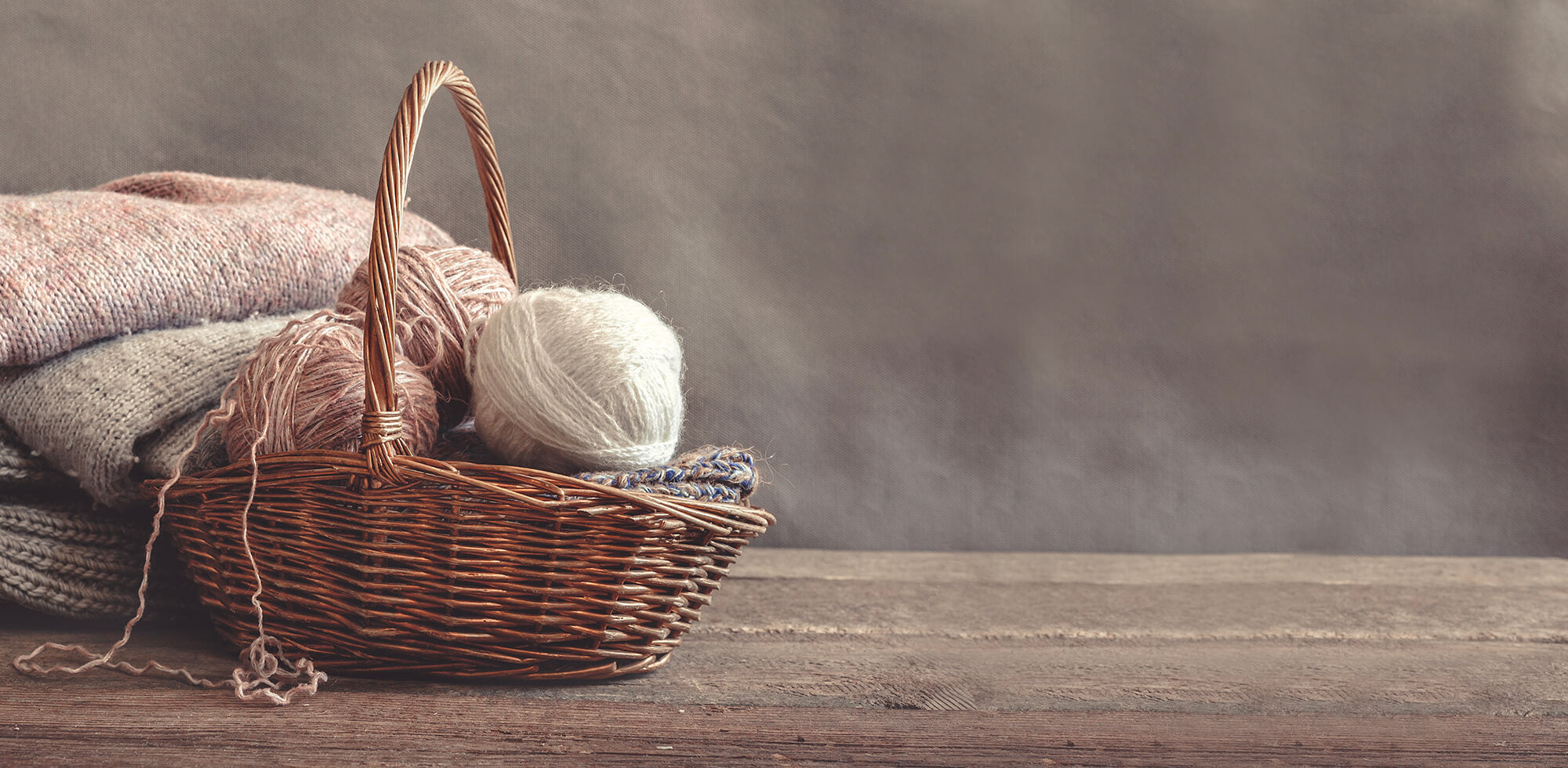By Claudia Ostrop
Brioche knitting, also known as English Rib Pattern, has a reputation for being a complicated technique in knitting.
We think it is completely unjustified because the different brioche variations are actually quite simple. There are basically three different types of brioche patterns: Basic brioche, half brioche and mock or fake brioche. And all three are not rocket science, but ultimately just fluffy 1x1 ribs: beautifully thick, stretchy and equally pretty to look at from both sides. How they are knitted is our topic today. We will introduce you to the three basic variations, which can be knitted in rows and rounds. You will soon be able to knit beautiful scarves! And if you get hooked, you can move on to knitting two-coloured brioche projects as well!
Brioche Variations
The brioche stitch pattern always produces a particularly voluminous fabric. When knitting the basic brioche pattern (as opposed to the so-called "mock" brioche), a stitch is only knitted in every other row or round. The lush, three-dimensional structure of the knitted fabric results from slip stitches and yarn overs as well as stitches worked one stitch below. English rib stitches are “yarn eaters”; you will wind up using a lot more yarn than when knitting in stockinette stitch. This will make the garment correspondingly heavier, so you should think carefully about which yarn you choose for a project. Normal cotton is quite unsuitable not only because it is heavy, but also because due to the weight, the fabric will stretch out and lose its shape easily. Super-wash yarns are also not ideal for brioche patterns, as they tend to "fluff". This would quickly cause the thick ribbing of the brioche to get out of shape. Thick, fluffy yarns are ideal for brioche patterns. Tibetan, for example, is a wonderful yarn for this. Merino Baby or Balayage knitted together with Manada are also beautiful alternatives.
So, let´s talk about the different brioche variations:
Basic Brioche
The basic brioche pattern is created by slipping stitches and creating yarn overs in one row and then knitting those stitches together in the following rows. This results in a striking reversible fabric which is lush and bulky. A variation of the brioche stitch is the Fisherman´s Rib which is typically made by stitching into the row below. The two variants do not differ in terms of appearance - the result is the same, only the way to get there is different. Whether you prefer to work with yarn overs or stitches in the row below is entirely a matter of taste.
Basic Brioche with Yarn Overs
The brioche stitch is created by working a combination of yarn overs with slip stitches from the row below and then in the subsequent row working those pairs together.
Basic Brioche with Yarn Overs in Rows
The brioche stich in rows is just a single row repeat on an even number of stitches. On the set up row, the very first stitch is the selvedge stitch (k1), then you slip or move one stitch over purl wise to the right needle and do a yarn over (sl1yo). Knit he following stitch. On the next row, you are going to slip a stich and do a yarn over (sl1yo). The next two stitches which are kind of on top of each other here will be knit together. This is known as a brioche knit stitch (brk). The following rows are worked in exactly the same way.
Set-up row: selvedge stitch (sl1yo, k1,) selvedge stitch
Row 2: selvedge stitch (sl1yo, brk) selvedge stitch. Repeat row 2 till the end.
Basic Brioche with Yarn Overs in Rounds
The whole thing also works in the round, of course. The set up row is a repeat of a knit stitch followed by a slip over and a yarn over. In the first round, all stitches are then purled together with their yarn overs (brioche purl = 1brp) and the knit stitches are slipped (sl1yo).
In round two, the purl stitches with yarn over are slipped (sl1yo) and the knit stitches are knitted together with their yarn over (brioche knit = 1brk).
After that, rounds 2 and 3 are repeated alternately until the end.
Set-up row: (k1, sl1yo)
Row 1: (sl1yo, brp)
Row 2: (brk, sl1yo)
Row 3: sl1yo, 1brk Repeat, rounds 2 and 3 alternately until the end.
Fisherman´s Rib
Here the brioche pattern, is not created by a yarn over but by knitting every second stitch one row below and letting that stitch unravel. It´s kind of intentionally dropping a stitch. This is the equivalent to a stitch knit together with its yarn over in brioche.
Fisherman´s Rib in Rows
The starting round is once again a repetition of a purl and a knit (p1, k1) framed by selvedge stitches. In the first and all following rows, all right stitches are then knitted one row below (k1b), i.e. by inserting the needle into the knit stitch below the stitch on the needle, knitting, and sliding both stitches off the needle. All purl stitches are purled.
Cast on even number +3 (2 selvedge stitches plus 1)
Row 1: k1 (k1, p1) to last 2 stitches, k2.
Row 2: k1, p1, (k1b, p1) k1.
Row 3: k1, k1b, (p1, k1b) k1. Repeat rows 2 and 3 for desired length, ending after a row 3.
Fisherman´s Rib in Rounds
This technique can also be done when working in the round. The starting round is once again a repetition of a purl and a knit (p1, k1). In the first round, you knit all the knit stitches one row below (k1b) and all the purl stitches as a normal purl. In the second round, the right stitches are knitted as they appear and the purl stitches are worked one row below (p1b). These two rounds are repeated till the end.
CO an even number of st.
Set up row: (k1, p1)
Row 1 and every odd row: (k1b, p1)
Row 2 and every even row: (k1, p1b)
These last two rows create the pattern. Repeat rows 1 and 2 until the desired length is reached.
Halfbrioche
The half brioche is a slightly less bulky knit. Here brioche stitches are only knitted in every other row or round: a row/round with yarn overs or stitches one row below alternates with one in which only knit and purl stitches are made. Unlike plain brioche, it is not a reversible pattern but has two distinct sides.
Halfbrioche with Yarn Overs
As with the basic brioche, the basis is a row or round of knit and purl stitches. The beautiful, clear rib can be formed with the yarn overs either on the knit side of the work (front side) or in the purl side (back side).
Halfbrioche with Yarn Overs in Rows
The starting point is the base row of knit and purl stitches. In wrong side rows, the slipped stitches with yarn over (sl1yo) alternate with knit stitches. On the right side rows, the yarn overs are knitted together with the purl stitches (k2tog).
Set-up row: k1, (p1 1, k1) k1
Row 1: k1, (sl1yo, k1) K1
Row 2: k1, (p1, k2tog) k1 Repeat rows 1 and 2.
Halfbrioche with Yarn Overs in Rounds
Work begins with a row in rib pattern. In the first brioche row, the purl stitches are knitted, the right stitches slipped off with a yarn over (sl1yo). In the second row, the stitches are knitted together with the yarn over (k2tog) followed by a purl stitch. These two rows are repeated until the end.
Set-up row: p1, k1
Row 1: k1, sl1yo
Row 2: k2tog, p1 Repeat rows 1 and 2.
Half Fisherman´s Rib
Here, too, the brioche pattern alternates with a row of knit and purl stitches. The knit stitch is always worked one row below.
Half Fisherman´s Rib in Rows
The base row (p1, k1) creates the rib pattern. In the first row, purl all the purl stitches and work the knit stitches one below (k1b). In the following row, work the stitches as the appear. Easy, right? The pattern results from a constant repetition of these two rows.
Set-up row: k1, (p1, k1) k1.
Row 1: k1, (k1b, p1) k1.
Row 2: k1, (p1, k1) k1. Repeat rows 1 and 2 to the end.
Half Fisherman´s Rib in Rounds
The Set-up row is worked in the rib pattern (p1, k1). In the first brioche row, all purl are purled and all knit stitches are worked one row below (k1b). In the second row, all stitches are knit as they appear. Rows 1 & 2, arew repeated alternately till the end.
Set-up row: (p1, k1)
Row 1: (k1b, p1)
Row 2: (p1, k1) Repeat rows 1 and 2 to the end.
Mock or Fake Brioche Rib
The fake brioche pattern is actually nothing more than a rib pattern. At first glance, it can hardly be distinguished from the “real” brioche. In contrast to the original, it only consists of knit and purl stitches. The volume results from the fact that the ribs contract due to the fact that they are arranged in an accordion-like manner.
Mock Brioche in Rows
You need a number of stitches that can be divided by four (plus selvedge stitches)
Row 1: K2, (P1, K3), P1, K2
Row 2: P1, (K3, P1) Repeat rows 1 & 2 alternately.
Mock Brioche in Rounds
You need a number of stitches that can be divided by four.
Row 1: K2, P1 (P1, K3), K1
Row 2: (K1, P3) Repeat rows 1 & 2 alternately.
To Summarize
So, it's not all that difficult, is it?
It only gets a bit complicated if you need to correct a mistake. By using a "lifeline", i.e. a thread of yarn that runs through all the stitches in a row at regular intervals, this drama is kept within limits. It’s a preventive measure that keeps stitches safe in case you need to unravel your knitting later on for one reason or another.
You can learn more about that in our next blog post about brioche knitting. In it we devote ourselves to the two-colour brioche, talk about increases and decreases and a few first-aid measures.




1 comment
Kathrin
Hallo, ich bin nicht sicher, aber ich glaube beim HALBPATENT MIT UMSCHLÄGEN IN RUNDEN hat sich in Runde 2 ein Fehler eingeschlichen.
In meine in Runde 2 müssen die Umschläge mit der Masche rechts zusammen gestrickt werden und linken Maschen einfach links.
Oder ich habe es nicht verstanden. Das kann auch sein 🤭
LG Kathrin
Hallo, ich bin nicht sicher, aber ich glaube beim HALBPATENT MIT UMSCHLÄGEN IN RUNDEN hat sich in Runde 2 ein Fehler eingeschlichen.
In meine in Runde 2 müssen die Umschläge mit der Masche rechts zusammen gestrickt werden und linken Maschen einfach links.
Oder ich habe es nicht verstanden. Das kann auch sein 🤭
LG Kathrin